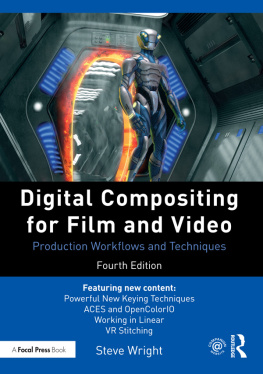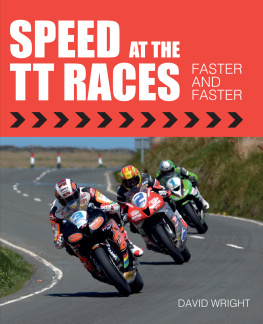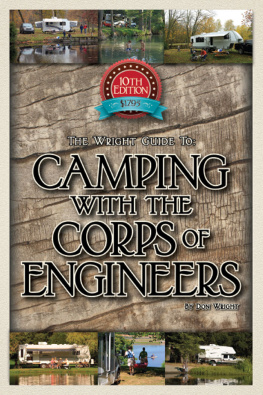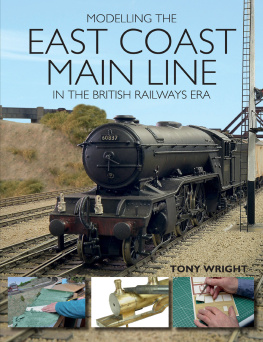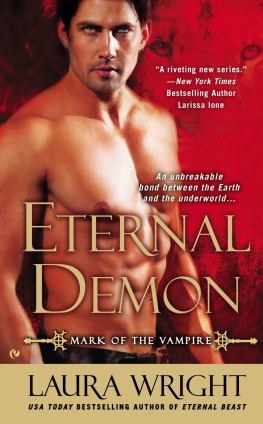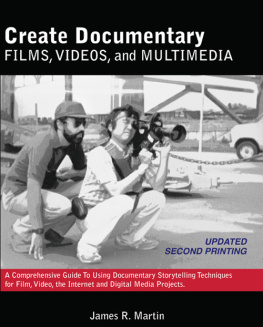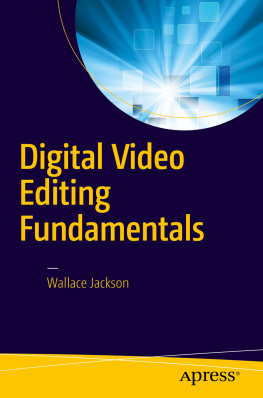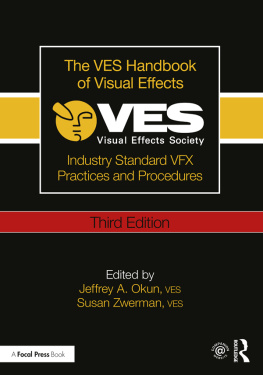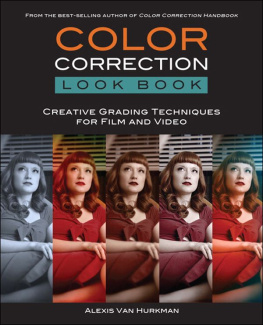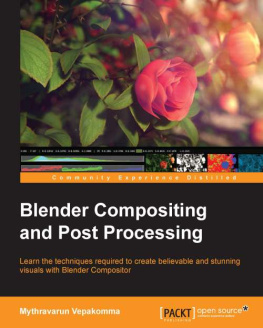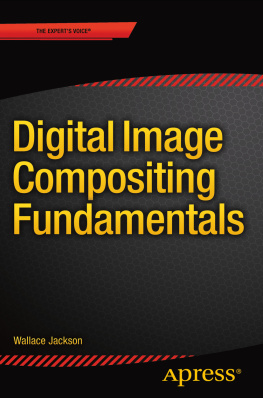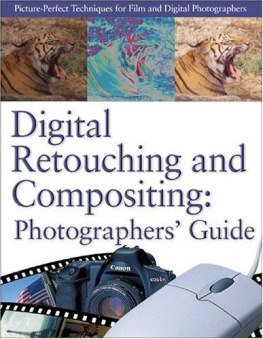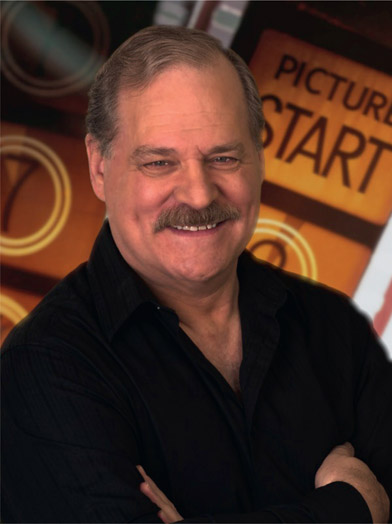Fourth edition published 2018
by Routledge
711 Third Avenue, New York, NY 10017
and by Routledge
2 Park Square, Milton Park, Abingdon, Oxon OX14 4RN
Routledge is an imprint of the Taylor & Francis Group, an informa business
2018 Taylor & Francis
The right of Steve Wright to be identified as the author of this work has been asserted by him in accordance with sections 77 and 78 of the Copyright, Designs and Patents Act 1988.
All rights reserved. No part of this book may be reprinted or reproduced or utilised in any form or by any electronic, mechanical, or other means, now known or hereafter invented, including photocopying and recording, or in any information storage or retrieval system, without permission in writing from the publishers.
Trademark notice: Product or corporate names may be trademarks or registered trademarks, and are used only for identification and explanation without intent to infringe.
First edition published by Focal Press/Butterworth-Heinemann 2002
Third edition published by Focal Press 2010
Library of Congress Cataloging in Publication Data
A catalog record for this title has been requested
ISBN: 978-1-138-24036-0 (hbk)
ISBN: 978-1-138-24037-7 (pbk)
ISBN: 978-1-315-28401-9 (ebk)
Typeset in Helvetica Light
by Alex Lazarou
Visit the companion website: www.routledge.com/cw/wright

Steve Wright is a visual effects pioneer and a 20-year veteran of visual effects compositing on over 70 feature films as well as 70 broadcast television commercials. With extensive production experience and a knack for the math and science of visual effects he is a world-recognized expert on visual effects compositing.
Since 2005 he has been a master trainer in compositing visual effects providing staff training to over 25 visual effects studios around the world including Pixar Animation Studios, Disney Feature Animation, Troublemaker Studios, New Deal Studios, Reliance MediaWorks, and many others. He has hundreds of video tutorials on Lynda.com, the worlds leading online education company, has won 2 Telly awards for his tutorials, a SMPTE (Society of Motion Picture and Television Engineers) Education award, and has created training materials for companies like the Foundry, Red Giant, Imagineer, and YUVSoft. He has students all around the world and to date has trained over 1,000 artists in compositing, and published two books on compositing available on Amazon.com.
Visit Steves training website at www.fxecademy.com
Awards:
- 2014 SMPTE Kodak Educational Award for outstanding VFX training
- 2010 Telly award for outstanding tutorial videos Lynda.com
- 2010 Telly award for outstanding tutorial videos CG Society
- 2008 Telly award for best VFX for a fantasy short film DORME
- 2006 Presidents Volunteer Service Award for VFX training in Macedonia
- 1993 PROMAX Gold Medallion Award for ACTION 7 News, Florida, campaign
- 1992 Regional Emmy for CGI in MASTERS OF ILLUSION for The National Academy of Television Arts and Sciences.
- 1991 Dentsu Award (Japanese CLIO) for outstanding CGI commercial REGAL SHOE
Writing a glossary for a rapidly evolving field with unstable terminology like digital compositing is a tricky but necessary task. A task that is further complicated by an infusion of terms from many other disciplines such as conventional opticals, special effects, photography, computer science, and signal processing. However, it needs be done, so it is done here with the intent of being more helpful to the digital artist than the engineer. Many terms are very technical in nature, but the unabashedly technical definition is often less than helpful to someone trying to make a good composite than a more common sense, task-related definition, so the common sense style prevails in this glossary.
Some of the words in the definitions are highlighted in bold to indicate that those words are also defined in this glossary.
Numerical
2D transformation moving an image only in two dimensions, such as a translation, scale, or a rotation.
2k literally 2,000, but in computerland it is 2,048 (211).
2:3 pull-down (or pulldown) another term for 3:2 pull-down .
2:3 pull-up (or pullup) another term for 3:2 pull-up .
3-perf slang for a 35mm film format where each exposed frame on the film spans three perfs (perforations). Saves film and lab costs.
3D animation (3D) animation created in a computer by creating three-dimensional models of objects, then lighting and animating them.
3D compositing to incorporate 3D geometry, lights, cameras, and other 3D functions into a 2D compositing program.
3D coordinates the X, Y, and Z coordinate system used to define the location of a point in three-dimensional space.
3D geometry a three-dimensional object defined by polygons used in 3D animation . Can include points and particle systems.
3:2 pull-down (or pulldown) a timing scheme to stretch the 24 frame per second rate of film to the 30 frame per second rate of video. Groups of 4 film frames are spread over 5 video frames by distributing the film frames over 10 video fields in the pattern 2, 3, 2, 3. Also referred to as a 2:3 pulldown.
3:2 pull-up (or pullup) the process of removing the 3:2 pull-down from film transferred to video in order to restore the frames to their original 24 frame per second rate. Also referred to as a 2:3 pullup.
4:1:1 video digitized with 4 samples of luminance and 1 sample of chrominance every 4 pixels. When converted to an RGB image the luminance will be full resolution but the colors will be 1/4 resolution.
4:2:0 video digitized with 4 samples of luminance and 1 sample of chrominance every 4 pixels. When converted to an RGB image the luminance will be full resolution but the colors will be 1/4 resolution like 4:1:1 but with a different sampling pattern.
4:2:2 video digitized with 4 samples of luminance and 2 samples of chrominance every 4 pixels. When converted to an RGB image the luminance will be full resolution but the colors will be half resolution.
4:4:4 video digitized with 4 samples of luminance and 4 samples of chrominance every 4 pixels. When converted to an RGB image both the luminance and colors will be full resolution.
4k literally 4,000, but in computerland it is 4,096 (212).
4-perf slang for any number of 35mm film formats where each exposed frame on the film spans 4 perfs (perforations).
5-perf slang for the 65mm/70mm film format where one frame spans 5 perfs (perforations) of film.
65mm/70mm a large format film stock with a 65mm-wide camera negative and a 70mm-wide projection print with an aspect ratio of 2.2.
8-bit Images images that use 8 bits of data per channel, which results in a data range between 0 and 255 for each channel.
8-perf slang for the VistaVision film format where each exposed frame sits sideways on the film and spans 8 perfs (perforations).
10-bit Images images that use 10 bits of data per channel, which results in a data range between 0 and 1023.
10-bit log representing log data with 10 bits of precision.
A
Absolute difference the difference between two values where any negative values are converted to a positive number.
Academy aperture the rectangular area of a frame of film for cinema projection that leaves room for a sound track between the left edge of the frame and the perfs .
Next page
